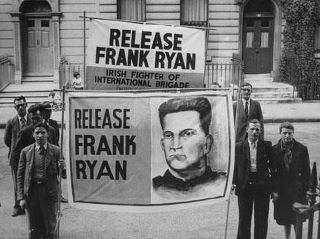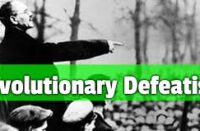Historical revisionism is a great tool for the bourgeoisie. It shows no nuance when demonising those who fought for the workers, and it can be used to either ignore or heavily downplay the fact a person was a socialist or communist. Frank Ryan is a victim of this, as although he should go down in history as a staunch anti-fascist and hero of Spain, he is tarred by some with being classified as a Nazi collaborator.
This is part one of a two-part article. This first article will deal primarily with Frank Ryan until his transfer to Germany in 1940. The next article will look into the lies and misunderstandings surrounding Ryan’s time in Germany until he died in 1944.
Frank Ryan was a very dedicated anti-imperialist. Long before he went to Spain, he joined the IRA and fought against the Anglo-Irish treaty. While fighting he was wounded and interned. Even after the 1923 arms dump by the IRA and the creation of Fianna Fáil in 1927, which led to many members switching allegiance to bourgeois parliamentary politics, Ryan remained an active member of the IRA.
The 1930s saw the IRA’s support dwindling more and more. By 1933 Frank Ryan was one of several members of the IRA who believed that they should engage more in social programs to help boost support. Frank understood that without the support of the working class, there would be no IRA, so he along with Peadar O’Donnell and George Gilmore challenged the IRA leadership, which resulted in the men being
court-martialed and expelled from the IRA in March 1934. This led to the creation of the Republican Congress, of which Ryan would be an important member.
He was not some apolitical physical force republican: he had a deep understanding of Marxism and colonialism. This can be seen by his attendance at the first conference of the “League Against Imperialism” (LAI) along with Donal O’Donaghue. Once more proving his internationalist anti-imperialism at an LAI meeting in 1930, he concluded one talk by claiming “three cheers for India!”
He stood in the 1936 Dublin municipal elections in the North-East Ward as a Republican Congress candidate and in his manifesto he called for better rights for Republicans and especially for tenants. He also pledged to introduce “The politics of advancing Republican and labour struggles”. He was not elected and received 418 votes.
Frank Ryan was an active fighter of Fascism in Ireland before he went to Spain. When the Blueshirts were marching through the streets he, along with the likes of Tom Barry, Sean Murray, Peadar O’Donnell and others, fought them off in numerous street fights.
When the Spanish Civil War began, Frank Ryan led the first Irish group to Spain in December 1936. While Frank was never a member of the Communist Party of Ireland, he did join the Spanish party during the Civil War.
The Irish Volunteers were straight into action on the 24th of December 1936 as they fought in Córdoba. Frank would then be wounded in Jarama in February 1937. During the battle he and Jock Cunningham, of the British battalion, tried to raise morale of the soldiers by singing the Internationale.
In March 1937 he was wounded again and returned to Ireland for a brief time, but as he was an ardent anti-fascist, he returned to Spain to continue the fight and was captured by Italian soldiers in March 1938. When he was captured, he was the most senior International Brigade prisoner.
One story demonstrates how fallacious is the idea that Ryan would go on to collaborate with the same men he was shooting at in Spain: “[Italian soldiers] lined him up on the road with all the other prisoners and with bayonet-prods tried to force him to give the fascist salute. Ryan with a proud bearing refused. Under the threat of death, they persisted in their efforts, but he continued to treat them with contempt. They then placed him in front of a firing party and proceeded to enact the motions of an execution. He remained adamant.”
Why would a man who wouldn’t even perform a fascist salute under threat of death turn into a willing collaborator? Frank was then taken to a concentration camp at Mora del Ebro where he was tortured. He was sentenced to death but due to opposition organised in Ireland, this was commuted to 30 years in prison. He would then be sent to Berlin in 1940 and his work from 1940 until 1944 is where the controversy surrounding his life comes from.
To be continued in part two.






